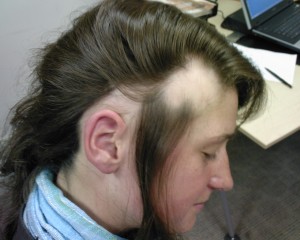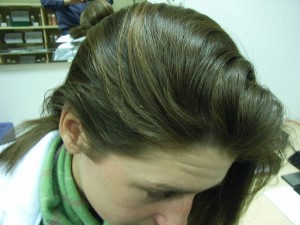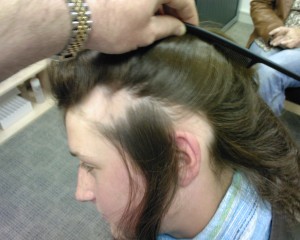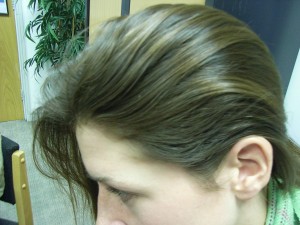More treatment options for alopecia areata
06 Jun 2008, by in ALOPECIA AREATA, UncategorizedBEFORE AND AFTER TREATMENT AT THE HAIR CENTRE
These results were achieved with a combination of treatment therapy.
Topical immunotherapy
It is thought that topical immunotherapy is the most effective option for people with extensive alopecia areata. However, this treatment is only done by some skin specialist and so you will need to be referred to one of these specialists for it.
How topical immunotherapy works is not clear. A substance is put on affected skin to to make the skin react like an allergy. The most commonly used substance is DPCP (diphencyprone). Increasing strengths of this substance are placed on the affected skin once a week over several weeks until the skin looks like it has mild dermatitis (eczema). The skin reaction seems to affect the process involved in causing alopecia areata in some way to allow hair to re-grow. Side-effects from topical immunotherapy can be troublesome. For example, some people develop severe skin reactions. Treating children with topical immunotherapy is controversial.
In a large study of people with extensive alopecia areata, topical immunotherapy caused good hair re-growth in 3 in 10 cases after six months which increased to nearly 8 in 10 cases after 32 months of treatment. (It worked less well in people with alopecia totalis or alopecia universalis.) In those where it works, initial re-growth does not occur for 12-24 weeks. Once re-growth occurs, treatment can be stopped but in many cases the hair loss then recurs. Therefore, in many cases, regular maintenance treatment is needed to keep the hair loss from returning.
Dithranol
Dithranol is thought to be less effective than topical immunotherapy, but works in some cases. It is applied each day to the whole scalp if there is extensive hair loss and left for 20-60 minutes before washing it off. One study showed that it helps hair re-growth in about 1 in 4 cases, but takes many weeks of treatment. Side-effects such as itchiness, redness, and scaling are common with dithranol. Dithranol is not widely used for alopecia areata because it is messy to use.
Do you have Hair Loss Problems, read our Hair Loss Help










Sorry, the comment form is closed at this time.